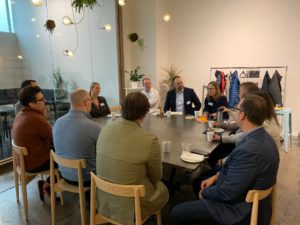 Product leadership has never been harder or more rewarding. Yesterday marked the first Product Leaders Peer Event in Minneapolis! The level of talent and conversation was fantastic. We wanted to help bring the product leader community together and have a safe place to talk openly about the challenges of leading product teams. We also wanted to create a forum for product leaders to connect outside of their own companies and industries to see what is working and what isn’t when leading product teams.
Product leadership has never been harder or more rewarding. Yesterday marked the first Product Leaders Peer Event in Minneapolis! The level of talent and conversation was fantastic. We wanted to help bring the product leader community together and have a safe place to talk openly about the challenges of leading product teams. We also wanted to create a forum for product leaders to connect outside of their own companies and industries to see what is working and what isn’t when leading product teams.
Here are the key themes that emerged from the group:
Strategy & Innovation
How do you give your product teams the space needed to try something that has never been done? Setting expectations with stakeholders is critical to establishing the culture where you are actually rewarded for things that don’t work.
A major challenged faced by the group was the difficulties in giving product teams the space they need to drive innovation and fail. The real reason leaders don’t really like to fail is because they are grounded in near-term goals and incentives. Key learnings and demonstrative results are required for senior leaders to have a long-term view on innovation.
Goal: Have your product teams immersed in the present and the future. Don’t have your product team only focused on the current sprint. Conversely, product teams don’t deliver when solely focused on 12 months out or further. The good product leaders seem to focus on both the present and future equally.
- Skunkworks projects that bring cross-functional teams together for a specific time and goal can help

Management
“When will we be done?” We’ve all heard that question from leaders. But what is the real meaning of that question? Often, we get that question because the senior leader doesn’t really understand the product model for development. As the group stated – there really isn’t a ‘done.’
How to help senior leadership understand product methodology? This was a good topic on leading up and shielding your teams to let them drive work and customer results. Never easy, but blocking and tackling
Remembering positive intent is vital. Stakeholders and other teams aren’t trying to be barriers to product teams, they are simply aligned to their own team culture and goals.
- Selling the vision across the organization is a central function that falls under product leadership.
- Get engineers closer to the customer. The critical need to have engineers understand the customer and the product from a business perspective
- Product teams need to know the Why behind a request. Saying no is a critical skill. Prioritization requires the rationale behind the request to measure value vs. viability
Talent
- Buy or Build Talent? This was a great way to think about your talent strategy. Are you going to hire top senior talent and get out of the way (Buy), or, are you going to hire more junior talent and develop them into strategic leaders? (Build) Hybrid approaches often make sense but require strong team leadership to work between the junior and senior talent.
- Finding talent is a significant challenge. Many organizations convert BAs and other roles but risk having the wrong person in the wrong seat.
- How to teach your team through the stumbles as they are developing as product managers is a critical skill for the product leader. Ask the question “What would you do?” to help grow and develop product managers.
- Play to the strengths of the team when building it. Understand the technical, business and experience skills to balance the team and complement each other.
- Interviewing product owners: a 2-hour group interview and case study evaluation. The challenges are if people absorb information differently, they may not be at their best when they have to think on their feet.
If you didn’t get a chance to join the first breakfast, Contact Us and let’s connect!



